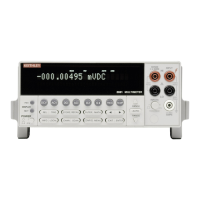IEEE-488 Reference
4-119
Short-form formats: :curr:ac:aper? :curr[:dc]:aper?
:curr:ac:aper? xxx :curr[:dc]:aper? xxx
:volt:ac:aper? :volt[:dc]:aper?
:volt:ac:aper? xxx :volt[:dc]:aper? xxx
:res:aper? :fres:aper?
:res:aper? xxx :fres:aper? xxx
:temp:aper?
:temp:aper? xxx
where; xxx = def, min or max
Response message: 166.6666666667e-6 to 200e-3 seconds
Description
These commands are used to set the integration period for the measurement functions. The in-
tegration period for a triggered reading (measurement) can be expressed as aperture (seconds
per integration). In general, a short integration period provides a fast reading rate, while a long
integration period provides better accuracy. Typically, the selected integration period is based on
a compromise between speed and accuracy. Any triggers received while the instrument is pro-
cessing a reading will be ignored.
An alternate way to set the integration period is by basing it on the number of power line cycles
(see :NPLCycles command). If the number of power line cycles per integration (NPLC) is al-
ready known, aperture can be calculated as follows:
where; Aperture is the integration rate in seconds per integration.
NPLC is the number of power line cycles per integration.
f is the power line frequency. (Note: For 400Hz line power, use 50Hz to calculate ap-
erture).
Keep in mind that when the integration period is set using the :APERture command, the value
for the :NPLCycle command will change accordingly to reflect the new integration period.
Conversely, if the integration period is set using the :NPLCycle command, the value for the
:APERture command will change accordingly.
On power-up, the instrument will use the NPLC value to determine the integration period. Thus,
if using a different power line frequency, NPLC will remain the same, but aperture may change.
Note: If line synchronization is enabled (see:LSYNc command in SYSTem subsystem), the in-
tegration period will not start until the beginning of the next power line cycle. For example, if a
reading is triggered at the positive peak of a power line cycle, the integration period will not start
until that power line cycle is completed. The integration period starts when the positive-going
sine wave crosses zero volts. See paragraph 3.12 for more details.
Programming example
10 OUTPUT 716; “:curr:ac:aper 16.67e-3; aper?”
20 ENTER 716; A$
30 PRINT A$
40 END
Line 10 Sets aperture for ACI and then queries the programmed aperture.
Line 20 Addresses the Model 2001 to talk.
Line 30 Displays the programmed aperture value.
Aperture
NPLC
f
---------------=

